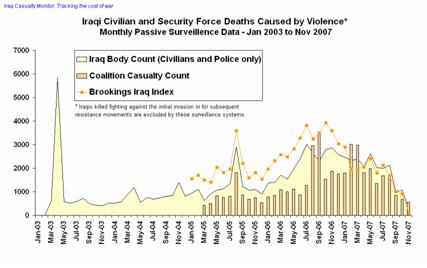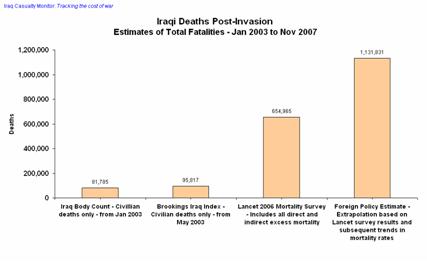 Updated: 20th December
Updated: 20th December
Casualty data analysed to: November 2007
Duration of war: 4 years, 8 months
Estimates of violent civilian deaths: 78,280 - 95,817
Estimates of total excess Iraqi deaths:
392,979 - 1,131,831
Total Iraqi casualties: no data available
The extent of the death toll resulting from the US-led invasion of Iraq and the following occupation and insurgency, continues to be the subject of debate. Ever since 2003, scientific discussion, heated debate in the media, and political spin and manipulation, have all been prominent as various stakeholders have strived to define a figure for the human cost to the Iraqi people.
As claims mount about the success of the US military surge in Iraq it appears that there is real evidence that the Iraqi casualty rate may be falling. Welcome news indeed. To try and gauge what the extent to which this is true we are pulling together various estimates and data sources on casualties, both civilian and combatant.
When undertaking this review it quickly becomes apparent that there is still no one definitive or completely reliable source.
We have previously
reviewed the limitations of the available data sources on casualties. To illustrate the range of estimates that exist we have constructed a graph of some of the
publicly available estimates, drawing on the following sources:
Brookings Iraq Index
Lancet 2006 Mortality Survey
Coalition Casualty Count
Foreign Policy Estimate
Associated Press
Iraq Body Count
UNAMI
In the first graph we show monthly mortality estimates from 3 passive
surveillance systems. Complete coverage of the war time period is only available from Iraq Body Count. However, it is worth noting that the estimates
achieved by this project seem to be systematically lower than those from the Brooking
Institute, which made adjustments to the
IBC estimates using Iraqi Ministry of health data. The data from the Coalition Casualty Count is clearly presented on their site as being an incomplete underestimate of Iraqi deaths. Indeed, all three passive
surveillance systems are almost certain to be seriously
underestimating Iraqi mortality. This is not unexpected and is not a criticism of their methods per
se. It just need to be clearly acknowledged, as it is by the Coalition Casualty Count project.

It is very important when looking at different estimates to bear in mind that they are not all trying to to measure the same thing.
Iraq Body Count for example, which monitors media reports and some other sources to derive its estimate, is concerned with only civilian and police deaths and so will exclude deaths of members of the armed forces, militia, resistance, or terrorists. Other studies, such as the Lancet mortality surveys, have attempted to estimate the entire death toll including all categories of people. Therefore, even if their figures were representative of the entire population there is no reason to suppose that the estimates of deaths would be the same.
When trying to unravel the various sources of information on war deaths it is useful to distinguish between different types and causes of mortality. Death is as certain as taxation so in all populations there will be a 'normal' rate of mortality caused by causes such as chronic disease, old age, and traffic accidents. However, when an event such as a war occurs there will be additional deaths. These deaths are referred to as 'excess' mortality.
In Iraq, this excess mortality consists of deaths caused
directly by war-related violence and deaths caused
indirectly by the breakdown in infrastructure, law and order, and public health during and following the invasion.
Deaths are also measured in different population groups. Different methods distinguish in various, and not always consistent ways, between
members of the previous Iraq military forces, occupation Forces, civilians, Iraq security forces and insurgents.
The second graph presents 4 estimates of total Iraqi fatalities. Bear in mind that these are estimates of different things. However, it is well known by epidemiologists that passive
surveillance systems will tend to underestimate mortality compared to active approaches such as population surveys....



